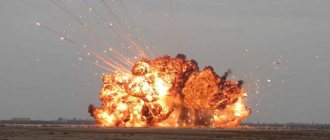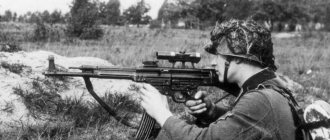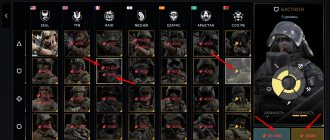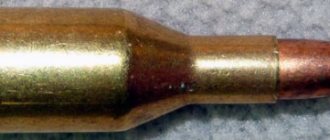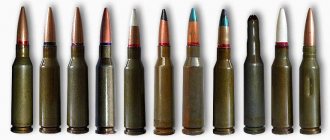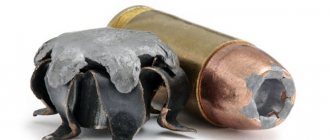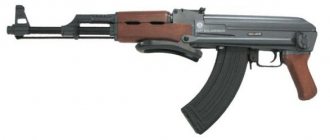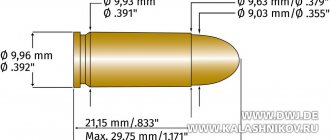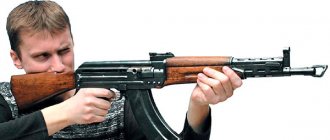Collector's cartridge. .38 Smith & Wesson.
In 1877, the .38 Smith & Wesson revolver cartridge appeared on the arms market, filled with black powder, which was later replaced by smokeless powder. This cartridge was most often used in revolvers with a double-action trigger with a tilting cylinder, such as the Smith & Wesson Regulation Police model.
The .38 Smith & Wesson cartridge was designed for Smith & Wesson's break-action revolvers (in this case the .38 Single Action) which were very popular in the last decades of the 19th century. The year of manufacture 1877 indicates that this cartridge was loaded with black powder, which, like many other ammunition, was later replaced by more modern smokeless powder.
No other revolver cartridge had more names. The .38 Smith & Wesson cartridge is also known as the .38 Colt New Police, .38 Super Police, and the English standard .38/200 cartridge, where "200" denotes a 200-grain (13 g) bullet weight. Ammunition. 38 Smith & Wesson gained a worldwide popularity that only began to wane after World War II. The .38 Special cartridge was introduced by Smith & Wesson in 1902 for K-frame revolvers. It began to replace the .38 Smith & Wesson cartridge in small frame models.
The best times of the latter began with the advent of revolvers with a double-action trigger and a drum that tilted to the side. In 1905, Colt introduced the Police Positive .38-caliber revolver. For him, the .38 Smith & Wesson cartridge was modified and named .38 Colt New Police. This was followed by the successful Police Positive Special revolver. On March 5, 1917, Smith & Wesson began producing the Regulation Police revolver chambered in .38 Smith & Wesson. Also, other weapons manufacturers in the USA and Europe produced various models of revolvers for this ammunition. The .38 Smith & Wesson cartridge was especially widespread in the countries of the Commonwealth (an interstate association of Great Britain and most of the former English dominions, colonies and dependent territories. - Translator's note), as well as in South America.
Purely English solution
After World War I, the British War Department began searching for a successor cartridge for its armed forces to replace the .455 Webley, which experts assessed as overly powerful. Based on this, the new Webley break-frame revolver was chambered for the .38 Smith & Wesson cartridge. However, the original cartridge from the USA was loaded in accordance with the needs and wishes of British customers. This is how the .38/200 ammunition appeared, equipped with a lead bullet with a rounded head weighing 200 grains (13 g). In 1937, a number of comments were made that the lead bullet was not suitable
At one time, the .38 Smith & Wesson cartridge was very popular among owners of revolvers with double-action triggers with small frames.
Hague Convention of 1907 “On the Laws and Customs of War”. The consequence was that the cartridge began to be loaded with a full-jacket bullet with a rounded head weighing 178 grains (11.5 g). In 1932, in the British army as standard ammunition for Enfield No. 2 the .38/200 cartridge began to be used; at the same time, the Webley revolver was not withdrawn from service. To these two models, during World War II, Smith & Wesson revolvers were added with a double-action trigger, with a medium-sized frame and a tilting cylinder, which received the designation British Service. Between 1940 and 1945, 568,204 British Service revolvers were produced. In connection with the fulfillment of a contract from the British Ministry of Defense, Smith & Wesson was even forced to suspend production of the standard .38-caliber Military & Police revolver, intended for the US army and police. April 24, 1942 became the date of production of the millionth copy of this model, after which a new accounting began and the letter V was placed before the serial number of the weapon. In Great Britain, revolvers with such serial numbers received the designation Victory Model. Also in this case, in addition to the standard .38-caliber revolver for the US Army and Police Military & Police, a model was simultaneously produced for the British Armed Forces.
During World War II, a number of small changes were made to the design of the revolver. The most significant of these was the new trigger locking system, installed in revolvers with serial numbers after V 769000. In addition, the letter S was added to the letter V. The last revolver produced during the war had the serial number VS 811119.
The .38/200 cartridge for Webley and Enfield revolvers continued to be used by British security forces until the late 1960s. For example, these included the Royal Ulster Constabulary and the Ulster Special Constabulary. In the United States, Smith & Wesson ceased production of .38-caliber revolvers with double-action triggers in the 1970s. Most notably, the Smith & Wesson .38 Regulation Police model was discontinued in 1974. The last model of the Regulation Police .38-caliber J-frame revolver, produced under government orders, was numbered 33 (Modell 33). The cylinder capacity was five rounds, which is typical of various Smith & Wesson small-frame .38-caliber revolvers.
Compared to Great Britain and most former British dominions, colonies and dependent territories, as well as the United States, the .38 S&W cartridge was less common in Central Europe. Currently, revolvers chambered for this cartridge can be found mainly among weapon collectors.
Guaranteed supply
The .38 Smith & Wesson cartridge is currently produced by major ammunition manufacturers and is loaded with lead bullets weighing 145 to 146 grains (9.5 to 9.4 g). It will probably be produced for a long period of time due to the availability of a simply gigantic number of used revolvers. However, you should pay attention to the fact that the cartridges currently available for sale are filled with smokeless powder and cannot be used for firing from weapons designed for ammunition with black powder. Some revolvers simply cannot withstand the increased loads. Of course, the law requires that .38 Smith & Wesson smokeless powder cartridges be fired at reduced loads in weapons designed for black powder ammunition.
Quite modest characteristics
By modern standards, the .38 Smith & Wesson cartridge has rather modest external ballistic characteristics. According to manufacturers, when fired from a weapon with a barrel length of 102 mm (4”), the initial flight speed of a lead bullet with a rounded head weighing 146 grains (9.4 g) is 209 m/s, which corresponds to an energy of 207 J. Currently The .38 Smith & Wesson cartridge is produced by companies such as Remington, Winchester, Magtech and PPU (Serbia).
| | Bullet weight (g/g) | Bullet type | Capsule | Powder charge (g) | Chuck length (mm) | V0 (m/s) |
| Winchester | 140/9,1 | Hornady Lead FP | CCI 500 | 2.2 Rottwell P 804 | 27,2 | 203 |
| Winchester | 140/9,1 | Hornady Lead FP | CCI 500 | 2.5 Hodgdon HP-38 | 27,2 | 211 |
| Winchester | 158/10,2 | Speer Lead SWC | CCI 500 | 3.0 Alliant Unique | 27,1 | 208 |
| Winchester | 158/10,2 | Speer Lead SWC-HP | CCI 500 | 2.6 Alliant Red Dot | 27,1 | 225 |
| Winchester | 158/10,2 | Speer Lead RN | CCI 500 | 2.5 Winchester 231 | 27,2 | 204 |
| Winchester | 158/10,2 | H&N SWC HS | CCI 500 | 2.7 Alliant Red Dot | 27,2 | 229 |
| Weapon tested: Smith & Wesson Modell 33 revolver. Barrel length: 102 mm (4”). Case length .38 S&W: 19.69 mm (775”). Bullet diameter: 9.07 mm (.775”); in accordance with the size table of the Permanent International Commission for the Testing of Hand Firearms - 9.17 mm. Maximum pressure of powder gases when firing the .38 S&W cartridge: 1200 Bar. Maximum chuck length: 31.50 mm (1.240”). Further use of the data given in the table is carried out at your own risk. The author and publisher do not bear any responsibility. |
Problems with caliber
According to the Permanent International Commission for the Testing of Handguns size table, the maximum bullet diameter of the popular and currently popular .38 Special cartridge is 9.12 mm (.359”). At the same time, for the .38 Smith & Wesson ammunition it is 9.17 mm (.361”). This difference is a major concern when handloading .38 Smith & Wesson cartridges. As practice shows, .38 Special ammunition is equipped with bullets with diameters from 9.07 mm to 9.09 mm (from .357” to .358”). However, the .38 Smith & Wesson round would be best suited to a 9.14mm (.360”) bullet. However, they are not sold in specialized stores of large manufacturers. Therefore, we have to be content with bullets for .38 Special ammunition. When loading by hand, special attention should be paid to the tight fit of the bullet into the cartridge case.
The .38 Smith & Wesson cartridge was originally designed to be loaded with black powder, which was later changed to smokeless powder. (Source: size table of the Permanent International Commission for the Testing of Handguns)
The second question is how a slightly smaller bullet diameter affects shooting accuracy. Practice has shown that most modern revolvers with a double-action trigger chambered for the .38 Smith & Wesson cartridge, when using ammunition with a bullet with a diameter of 9.09 mm (.358”), have quite satisfactory shooting accuracy. At least this applies to cartridges with relatively soft lead bullets. The situation is more critical with cartridges equipped with jacketed bullets with a diameter of 9.07 mm (.357”). In this case, when using hand-loaded cartridges, you should pay attention not only to the tight fit of the bullet into the cartridge case, but also to the movement of the bullet along the rifling of the barrel, designed for a .38 Smith & Wesson ammunition bullet of a slightly larger diameter. In any case, it is recommended to conduct a series of test firings. Those who would like to have bullets with the diameter of the original .38 Smith & Wesson cartridge cannot do without casting them themselves. Demand for lead bullets for the new shooting discipline of Cowboy Action Shooting has led to a significant increase in bullet types with diameters ranging from 9.07 mm to 9.09 mm (.357” to .358”). Some of them weigh less than the standard .38 Special cartridge, which is 158 grains (10.2 g).
When shooting the Smith & Wesson Modell 33 Regulation Police revolver, DWJ magazine staff used cartridges loaded with the corresponding Hornady 140-grain (9.1 g) bullets.
In addition to factory ammunition, Starline also sells new factory cartridges. Corresponding sets of dies for manual loading of cartridges are supplied by all major major manufacturers from the USA. The author worked with a set of dies from Lee. All gunpowders used in .38 Special ammunition were used to load the cartridges. Accordingly, this makes it possible to install standard Small Piston pistol capsules.
DWJ findings
These days, the .38 Smith & Wesson cartridge is used primarily in collector's firearms. At one time it was extremely popular among owners of service revolvers. So, mainly before World War II, they were equipped with revolvers produced by Smith & Wesson and Colt. The latest models of revolvers, produced in 1974, were developed by Smith & Wesson to chamber the .38 Smith & Wesson cartridge, initially loaded with black and later smokeless powder. Due to the fact that the .38 Smith & Wesson cartridge was very widespread at one time, components for its equipment are still available in sufficient quantities today. Handloaders should be aware that a .38 Smith & Wesson cartridge should never be chambered with a powder charge designed for the .38 Special cartridge.
Hans J. Heigel Translation by Victor Nazarov
Equipment
Initially the barrel had 6 grooves. But the resulting launch speed of less than 110 m/s was insufficient for a weapon intended for training purposes. The design with 18 grooves was abandoned due to high cost and practical unreliability: the bullet's flight distance was unsatisfactory, and when using lightweight ammunition, the inner surface of the barrel was covered with lead dust. As a result, the IZH-38 rifle was equipped with a barrel with 12 grooves.
The barrel box was conceived from solid metal. But experiments have shown that the welded tubular version is better. Similarly with the piston cocking system: the designers preferred a welded version rather than a solid one. And also, for the purpose of production savings, they refused to process them using expensive turning and milling methods, and began to stamp and weld them using a spot method.
The knot where the rifle breaks was made of metal. But there was an option to use thick plastic. The stock of the IZH-38 models has two options: artificial with 2 internal cavities in the bend and butt, with a fixed butt plate, and also wooden. The plastic version has several types of notches, while the wooden version does not have any.
There is no safety lock in the IZH-38 rifle. There is only a blocker that prevents accidental firing when the weapon is loaded.
The sight is a front sight. Some models that went on the market in the early 1990s have the ability to install sighting optics.
Compressor springs are solid wire springs made of steel. In the early 1990s, some examples were equipped with twisted wire springs.
The rifle was sold in a cardboard box. The package included:
- compressor spring;
- ramrod;
- additional cuff with rubber rings;
- accompanying documents.
Rifle tuning
The great advantage of the IZH-38 air rifle is that it can be tuned. To increase the bullet's exit speed, you need to make the cylinder larger. This can be put into practice by lengthening the section where the piston extends. As a result, the gap to the fastening element of the cocking lever in the barrel block will increase.
You will have to disassemble the weapon and make an element with your own hands that transmits the cocking force to the pusher. The final size of this part must be at least 5 mm greater than the previous element. The material for work can be 3 mm steel. It is necessary to have a small recess in this element, this will increase the movement of the barrel during cocking.
Since the piston hook will be behind the groove in the cylinder body, it is also necessary to make a hole in the well of the release mechanism for inserting a pin. The work is completed by assembling the rifle and securing the 2.8 mm wire spring.
Areas of use
The IZH-38 air rifle is used primarily at training sites, where the basics of shooting are taught. The gun is also suitable for professional purposes and sports shooting competitions. This is the optimal weapon for plunging - playful shooting of targets in shooting ranges or tin cans at your leisure.
Since the rifle's power is low, it is impossible to use it as a hunting weapon. The only acceptable option is to shoot a small animal from a short distance.
Advantages and disadvantages
Like any weapon, the IZH-38 rifle has advantages and disadvantages.
| pros | Minuses |
| possibility of tuning and modification of the rifle | noticeable recoil when shooting, especially if the shooter is not heavy |
| repair and replacement of parts are not difficult | impractical single-shot mechanism |
| ergonomics, compactness, light weight | quality problems with rifles produced in the early 1990s |
| low cost, trouble-free search for weapons on the secondary market | gradual wear of the axial screw due to the need to break the barrel |
| possibility of installing an additional sighting system | inconvenient for sighting, high-mounted front sight |
| rifled steel barrel providing maximum bullet flight distance | significant trigger effort, the shot requires considerable physical strength |
The IZH-38 air rifle is a desirable purchase for many users, because it combines excellent engineering solutions, convenience and versatility of use, an affordable price and the possibility of tuning to increase power.
Design features
The choice of 4.5 mm caliber is not accidental. This is the minimum among the most popular calibers for air guns, designated by the British standards system as 0.177. Popularity and availability of appropriate production equipment are the main reasons for choosing this caliber. At first there was an idea to make a rifle for 4 mm caliber - for lead bullets or steel balls. But the value of 4.5 mm won, since there was a proven technology for the production of rifled barrels of small calibers.
Having overcome a long path of experiments and design changes, the IZH-38 single-shot air rifle, based on piston-spring technology, finally acquired the following features:
- forged 13mm barrel with 12 rifling and brass rail;
- trigger blocker of a loaded weapon;
- closed and fixed front sight, rear sight adjustable along the vertical and horizontal axis by a screw;
- cocking by breaking the barrel - moving down and back, then in the opposite direction;
- during the cocking process, a section of the barrel is exposed, into which a bullet is inserted manually;
- sight line length adjustable;
- metal surfaces with blued finish;
- the butt is made of dark plastic or birch.
